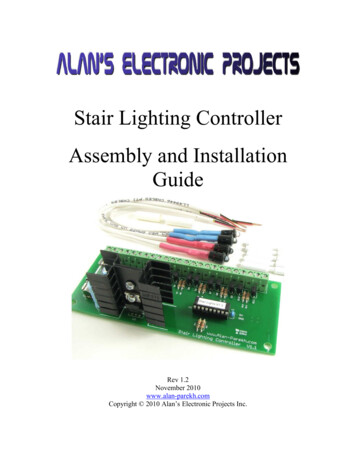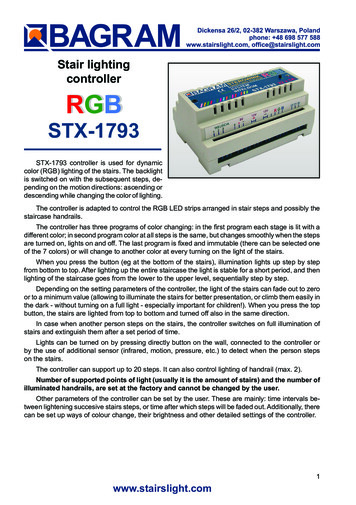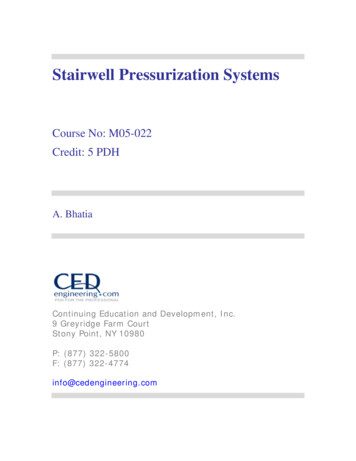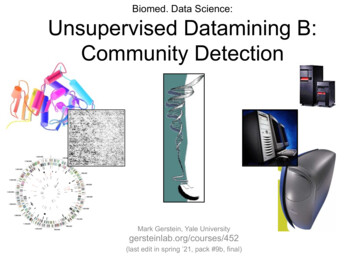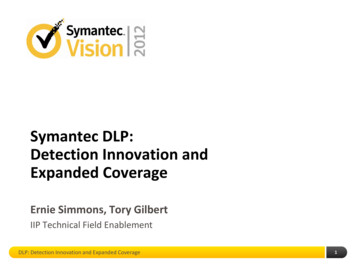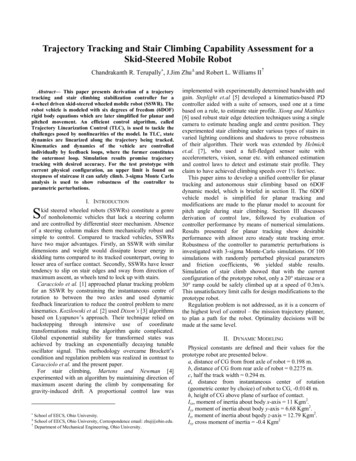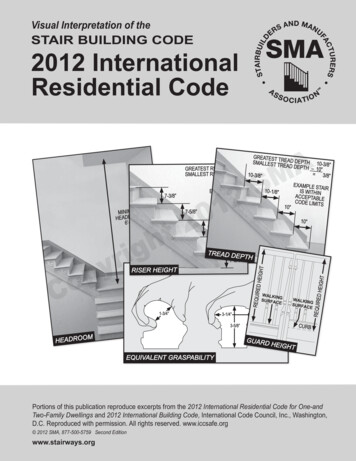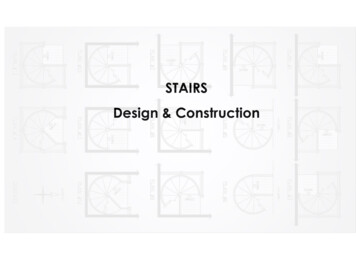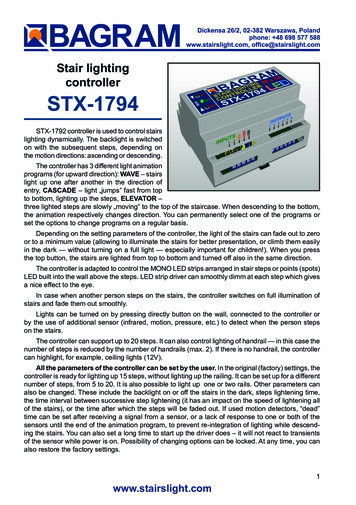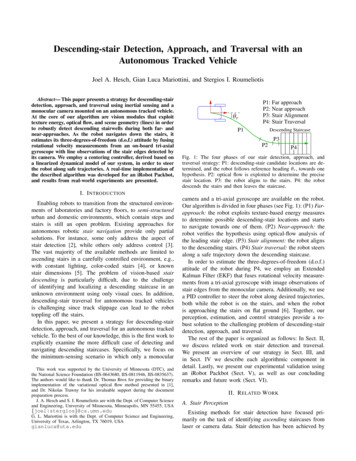
Transcription
Descending-stair Detection, Approach, and Traversal with anAutonomous Tracked VehicleJoel A. Hesch, Gian Luca Mariottini, and Stergios I. RoumeliotisAbstract— This paper presents a strategy for descending-stairdetection, approach, and traversal using inertial sensing and amonocular camera mounted on an autonomous tracked vehicle.At the core of our algorithm are vision modules that exploittexture energy, optical flow, and scene geometry (lines) in orderto robustly detect descending stairwells during both far- andnear-approaches. As the robot navigates down the stairs, itestimates its three-degrees-of-freedom (d.o.f.) attitude by fusingrotational velocity measurements from an on-board tri-axialgyroscope with line observations of the stair edges detected byits camera. We employ a centering controller, derived based ona linearized dynamical model of our system, in order to steerthe robot along safe trajectories. A real-time implementation ofthe described algorithm was developed for an iRobot Packbot,and results from real-world experiments are presented.θrP1: Far approachP2: Near approachP3: Stair AlignmentP4: Stair TraversalP1Descending StaircaseP3P2P4Fig. 1: The four phases of our stair detection, approach, andtraversal strategy: P1: descending-stair candidate locations are determined, and the robot follows reference heading θr , towards onehypothesis. P2: optical flow is exploited to determine the precisestair location. P3: the robot aligns to the stairs. P4: the robotdescends the stairs and then leaves the staircase.I. I NTRODUCTIONEnabling robots to transition from the structured environments of laboratories and factory floors, to semi-structuredurban and domestic environments, which contain steps andstairs is still an open problem. Existing approaches forautonomous robotic stair navigation provide only partialsolutions. For instance, some only address the aspect ofstair detection [2], while others only address control [3].The vast majority of the available methods are limited toascending stairs in a carefully controlled environment, e.g.,with constant lighting, color-coded stairs [4], or knownstair dimensions [5]. The problem of vision-based stairdescending is particularly difficult, due to the challengeof identifying and localizing a descending staircase in anunknown environment using only visual cues. In addition,descending-stair traversal for autonomous tracked vehiclesis challenging since track slippage can lead to the robottoppling off the stairs.In this paper, we present a strategy for descending-stairdetection, approach, and traversal for an autonomous trackedvehicle. To the best of our knowledge, this is the first work toexplicitly examine the more difficult case of detecting andnavigating descending staircases. Specifically, we focus onthe minimum-sensing scenario in which only a monocularThis work was supported by the University of Minnesota (DTC), andthe National Science Foundation (IIS-0643680, IIS-0811946, IIS-0835637).The authors would like to thank Dr. Thomas Brox for providing the binaryimplementation of the variational optical flow method presented in [1],and Dr. Nikolas Trawny for his invaluable support during the documentpreparation process.J. A. Hesch and S. I. Roumeliotis are with the Dept. of Computer Scienceand Engineering, University of Minnesota, Minneapolis, MN 55455, USA{joel stergios}@cs.umn.eduG. L. Mariottini is with the Dept. of Computer Science and Engineering,University of Texas, Arlington, TX 76019, USAgianluca@uta.educamera and a tri-axial gyroscope are available on the robot.Our algorithm is divided in four phases (see Fig. 1): (P1) Farapproach: the robot exploits texture-based energy measuresto determine possible descending-stair locations and startsto navigate towards one of them. (P2) Near-approach: therobot verifies the hypothesis using optical-flow analysis ofthe leading stair edge. (P3) Stair alignment: the robot alignsto the descending stairs. (P4) Stair traversal: the robot steersalong a safe trajectory down the descending staircase.In order to estimate the three-degrees-of-freedom (d.o.f.)attitude of the robot during P4, we employ an ExtendedKalman Filter (EKF) that fuses rotational velocity measurements from a tri-axial gyroscope with image observations ofstair edges from the monocular camera. Additionally, we usea PID controller to steer the robot along desired trajectories,both while the robot is on the stairs, and when the robotis approaching the stairs on flat ground [6]. Together, ourperception, estimation, and control strategies provide a robust solution to the challenging problem of descending-stairdetection, approach, and traversal.The rest of the paper is organized as follows: In Sect. II,we discuss related work on stair detection and traversal.We present an overview of our strategy in Sect. III, andin Sect. IV we describe each algorithmic component indetail. Lastly, we present our experimental validation usingan iRobot Packbot (Sect. V), as well as our concludingremarks and future work (Sect. VI).II. R ELATED W ORKA. Stair PerceptionExisting methods for stair detection have focused primarily on the task of identifying ascending staircases fromlaser or camera data. Stair detection has been achieved by
appropriately engineering the environment (e.g., detectingcolor-coded steps with a stereo camera [4]), or by limitingthe detection process to stairs of approximately known dimensions (e.g., known height [5]). Stair-detection based onGabor filtering of monocular camera images has also beenproposed [2]. These approaches benefit from the prominentappearance of the ascending staircase in the sensor data.However, to the best of our knowledge, there exists no workthat explicitly addresses the far more difficult problem ofdetecting descending staircases from monocular images.B. Stair TraversalThe task of stair ascending using tracked robots has beeninvestigated by several researchers. Vu et al. [7] designeda four-tracked robot, which climbs stairs by executing asequence of alternate rear and front track rotations. Althoughthe authors model the tread depth and riser height, the robot’sattitude is not estimated, therefore no heading correctionscan be computed during the ascent. In [8], a tracked robot isequipped with a suite of sensors (i.e., sonar, monocular camera, and two-axis accelerometer) to estimate its orientationwhile on the stairs. However, their approach does not fuse allavailable sensor measurements, but instead uses heuristics toselect the most accurate sensor. Still other approaches existwhich utilize only monocular vision [9], or a combinationof vision and gyroscopes [10] to estimate the orientation ofthe robot on the stairs. However, both [9] and [10] reliedon the limiting assumption that the robot has zero-roll angleand constant pitch while on the stairs.The predecessor to our current work [6], employed atightly-coupled vision-aided inertial navigation system (VINS) to estimate the three-d.o.f. attitude of the vehicle as itclimbed the stairs, based on the gyroscope measurements andmonocular observations of the stair edges. For controlling itsmotion, the robot switched between two heading strategieswhile on the stairs: (i) when near the unsafe stair-edge zone,it steered towards the middle of the stair, and (ii) when itwas in the middle of the stair, it steered strait up the stairs.In the current work, we build upon the estimation andcontrol framework presented in [6], to enable new capabilities for autonomous descending-stair detection, approach,and traversal. Our problem is significantly more challenging,since the descending staircase is not initially visible to therobot’s on-board camera, but its presence must be inferredfrom other visual cues. We present a novel detection algorithm which exploits scene texture [11] to infer candidatestair locations from a far distance, and optical flow [1]to precisely localize the leading-stair edge during the nearapproach. This in turn enables accurate stair alignment, andtraversal. We have validated our approach in real-world experiments, and demonstrate the performance of the proposedalgorithm in practice. In what follows, we present an in-depthdescription of our robust stair-descending procedure.III. A LGORITHM OVERVIEWWe denote the robot’s initial frame of reference as {R0 }.As the robot travels, the robot-affixed frame {Rt } changesin time. The three-d.o.f. orientation of the robot at time t0is described by the quaternion of rotation RRt q, which weestimate with a 3D-Attitude EKF. From the quaternion, weextract the pitch α and yaw θ components of the robot’sorientation.A. Data-Flow Description1) Stair perception: As depicted in Fig. 2(left), the stairperception module takes the camera data as input, andperforms texture analysis, optical flow, and line extraction onthe images. The lines are passed to the estimation module, tobe utilized for orientation updates. The heading reference θris passed to the controller to guide the robot during differentphases of the algorithm [see Fig. 2(right)].2) Estimation: The estimation module receives measurements from the tri-axial gyroscope in order to compute thecurrent attitude of the robot, with respect to the initial frame{R0 }. This information is fused with heading updates basedon the detected stair edges in a 3D-Attitude EKF in orderto obtain high-accuracy estimates. The estimation moduleprovides the controller with estimates of θ, θ̇, and α.3) Controller: The controller takes as input the currentestimates of θ, θ̇, and α from the estimator, as well as aheading reference signal θr , which is the desired headingdirection. This quantity will change according to which phasethe robot is in (e.g., driving towards a candidate stair locationor aligning to the stairs).B. Algorithm-Flow Description1) Far-approach: During the far-approach phase (P1), therobot uses a texture energy measure to generate hypotheses(image regions) for possible descending-stair locations, andselects one to investigate from a closer distance. As the robotmoves, it tracks the candidate stair location, and the referenceheading direction θr is set to coincide with the unit-vectortowards the centroid of the tracked region. When the trackedregion becomes sufficiently large in the image, we transitionto the near-approach phase (P2).2) Near-approach: In the near-approach phase, the robotverifies whether the current descending-stair-location candidate is valid or not. To this end, we exploit opticalflow and image line features in order to identify the depthdiscontinuity at the leading stair edge. If the stair edgeis detected, the robot transitions to the alignment phase,otherwise, it transitions back to the far-approach phase toinvestigate another hypothesis for the stair location.3) Alignment: During the alignment phase, the robottracks the leading-stair edge detected during the near approach and uses the edge direction to compute θr and alignperpendicular to the stairs.4) Stair Traversal: After the alignment phase the robottraverses the stairs. During this maneuver, the robot maintains a safe distance from both the left and right staircaseboundaries. When the robot is in the center of the stairs, thereference heading is perpendicular to the stair edges. Whenthe robot is near the left or right boundaries of the staircase,θr is selected to steer the robot back towards the center.
Algorithm FlowData FlowStair Perception texture analysis (s1)Camera optical flow (s2) line extraction (s3)Control m , θrGyro tion (e1)ωmP1: Far approachuses: s1, c1, e1q̂ α, θ, θ̇b̂ (c1) close?yesP2: Near approachuses: s2, s3, e1novalid?yesuRobotP4: Stair traversaluses: s3, c1, e1P3: Alignmentuses: s3, c1, e1Fig. 2: (left) The Stair Perception module extracts image features corresponding to descending stairs and passes them to the AttitudeEstimation and Control modules. The Attitude-Estimation module fuses rotational velocity measurements from the gyroscope, withobservations of straight-line edges extracted from the camera images, in order to estimate the three-d.o.f. orientation of the robot. TheControl module drives the heading and velocity of the robot to follow safe trajectories. (right) The Algorithm flow comprises four phases:P1 uses texture analysis to generate hypotheses for possible stair locations. P2 uses line extraction and optical flow to determine the stairlocation and the boundary of the first step precisely. P3 aligns the robot to the stairs. P4 drives the robot down the stairs.IV. S TAIR P ERCEPTIONA. Far-approach stair detectionIn this section, we present our vision-based approachfor descending-stair detection. Fig. 3(a) shows a typicalimage of an indoor environment observed by a mobile robotequipped with a monocular gray-scale camera. Descendingstair detection is challenging in this case since the stairs arenot directly visible in the image, and cannot be extracted bymeans of image features such as points or edges. Thus ouralgorithm must infer the presence of the descending stairsby exploiting other visual cues.Humans can detect possible descending-stair areas byperceiving the relative change in depth of surrounding sceneelements. To do this, they utilize a wide set of visual cues(e.g., monocular, stereo, motion parallax, and focus) [12].Among these, we are primarily interested in monocular information, since the other visual cues require larger motions ofthe camera, as the scene depth increases. However, inferringthe relative depth from a single image is difficult, becausedepth typically remains ambiguous given only local features.Thus, it is imperative to use a strategy that takes into accountthe overall structure of the image.In our proposed solution, we exploit monocular cues, inparticular texture variations, since they can be extremelyuseful for assessing changes in depth [13] (e.g., a carpet willexhibit a different texture resolution when observed at different distances). Among the existing texture descriptors, someof the most powerful ones use texture energy measures [14],which encode the amount of texture variation within afiltered window around a pixel. In [15], a supervised-learningapproach was proposed to estimate the 3D depth from asingle image. However, it relies on color-image processingand suffers from large computational burden. Instead, in ourwork we adopt Laws’ texture-energy measures [11], due totheir efficiency and computational speed.In the first texture-transformation step, the current imageI [see Fig. 3(a)] is filtered with a set of 5 5 masks Mk ,(a)(b)(c)(d)(e)Fig. 3: Far-approach phase: (a) An image of the indoor environment.(b) The texture-energy measure highlights candidate stair locations(low gray-level). (c) The binary image obtained after adaptivethresholding. (d) Candidate boxes indicate possible descending stairlocations. (e) One candidate is selected and tracked over consecutiveimages.k 1, ., 16:L5TE5, E5TL5, L5TR5, R5TL5, E5TS5, S5TE5,S5TS5, L5TL5, R5TR5, E5TE5, L5TS5, S5TL5,E5TR5, R5TE5, S5TR5, R5TS5,where the letters indicate Local averaging, as well as thesensitivity to Edges, Spots, and Ripples, for each of the four
5 1 basic masks:E5 [ 1, 2, 0, 2, 1], S5 [ 1, 0, 2, 0, 1],R5 [ 1, 4, 6, 4, 1], L5 [1, 4, 6, 4, 1].From the obtained filtered images Fk , the second texturetransformation step computes the local magnitudes of thesequantities. We apply a local-energy operator to each filteredimage to produce the texture-energy images Ek 1Ek (l, m) l pXm pX Fk (i, j) ,k 1, ., 16. (1)i l p j m pIn our experiments, we selected a window of size p 7 andcombined the various energies asE(l, m) 16XEk (l, m),(2)k 1which provided satisfactory performance.Fig. 3(b) shows the final energy image E which hashigh-energy values for pixels corresponding to close objectssuch as railings, trashcans, and ascending stairs. In contrast,far objects exhibit low-energy values, and hence indicatepossible descending-stair locations.After computing the energy image, in the third step weapply an adaptive threshold2 to obtain a binary image inwhich the 1s correspond to low-energy regions [Fig. 3(c)].From these binary regions a series of connected contourshave been extracted and each one has been fitted with abounding box. Among all these boxes, we discard thoseportions that lie below the horizontal line passing through theimage principal point. Note that, in the case of planar robotmotion, when far from the stairs, this line constitutes a goodapproximation of the horizon line, and thus, it upper-boundsthe floor plane. The remaining regions constitute the set ofpossible descending-stair locations, as shown in Fig. 3(d).At this point the algorithm randomly selects one of thecandidates, computes the reference heading θr with respectto its centroid, and uses it as an input to the controller (seeSect. IV-E). The robot moves towards the centroid of thechosen box, and tracks it through consecutive images usinga nearest-neighborhood approach [Fig. 3(e)].B. Near-approach stair detectionAs the robot approaches the selected candidate location, itneeds to assess whether it is a descending staircase or not. Ifthe robot was equipped with a 3D sensor (e.g., stereo cameraor 3D LADAR), it would be able to directly observe thestaircase and construct its 3D model, which would facilitatestair descending. However, our goal in this work is to addressall exteroceptive-sensing needs with a monocular camera. Tothis end, we exploit multiple visual cues (i.e., optical flow1 Although [11] used both squared and absolute magnitudes to estimatethe texture energy, we only utilize absolute magnitude, since it requires lesscomputation and gives comparable performance in practice.2 While the initial value of this threshold is selected manually, we designedan adaptive thresholding strategy for coping with illumination changes. Moredetails about this process are provided in Sect. V.and image lines), in order to verify the stair hypothesis, andidentify the leading stair edge.1) Line extraction: As the robot approaches the stairs [seeFig. 4(a)], it extracts all lines present in the image. The goalis to determine the line corresponding to the stair boundary,so the algorithm retains only image lines which satisfy thefollowing requirements: (i) they should lie in the lower halfof the image, (ii) they are not near vertical in the imageplane, and (iii) their length exceeds a specified percentage ofthe image resolution. This line-selection approach generatesseveral hypotheses for the leading stair edge [see Fig. 4(b)],however, because no depth estimates are available from theline-extraction process, it is impossible to determine the stairedge with this information alone.2) Variational optical flow: In order to infer which line, ifany, corresponds to the stair boundary, we combine the imagelines extracted in the previous step, with dense optical flowcomputed between sequential images. Traditional opticalflow methods rely on correlating points or patches across twoimages in order to determine the scene motion. However, wehave observed numerous cases in which correlation-basedoptical flow produces inaccurate results during the nearapproach phase, due to lack of sufficient texture on the floorand walls. For this reason, we have employed a variationaloptical flow method, introduced by Brox et al. [1], whichimposes additional constraints in the flow field to ensureconsistency in low-texture regions [see Fig. 4(c)].Specifically, for each candidate line extracted in an image,we compute the magnitude of the median flow within a smallwindow above the line, ρA , and below the line, ρB . Sincethe line corresponding to the true stair edge will have largeoptical flow below the line [denoted by the brightly coloredregion, ρA , in Fig. 4(c)], and low optical flow above the line[denoted by the dark region, ρB , in Fig. 4(c)], we utilizea ratio test to determine which lines may correspond to theleading stair edge (i.e., ρB /ρA ), and keep the ones whichpass this test.3) Voting for a candidate line: Typically, up to two orthree candidate lines may be selected from the previous step.Hence, we employ a final step, which is a simple votingscheme, to detect if one of the candidate lines is the leadingstair edge. Specifically, we cast three votes: (i) one for thelongest length line, (ii) one for the line with the largest ratioρB /ρA , and (iii) one for the line which is highest in theimage. If a line receives two or three votes, it is selected asthe leading stair edge [see Fig. 4(d)], otherwise the algorithmdeclares that no staircase is present, and returns to the farapproach phase as described in Fig. 2.C. Stair-alignment phaseAfter the robot completes the near-approach phase andverifies that an open stairwell is present, it must rotate toalign with the staircase. This is achieved by computing theunit vector along the stair-edge direction with respect tothe initial robot frame {R0 }, and subsequently, calculatingthe reference heading direction θr , allowing the robot todetermine the appropriate control inputs (see Sect. IV-E).
{Rt }x(a)yzeimagplaneφj(b) jρjΠjsicasestair(c)(d)Fig. 4: Near-approach phase: (a) Image recorded during the nearapproach. (b) Multiple lines are extracted which could correspondto the leading stair edge. (c) Optical flow is computed betweenconsecutive images and correlated with the detected lines. Thecolor indicates flow direction, and the brightness indicates flowmagnitude. (d) The leading stair edge is determined and markedin red.1) Determining the direction of the stair edge: Figure 5depicts the observation of the leading stair edge. Each lineprojected onto the image plane is described by TRt j cos φj sin φj ρj ,(3)where {φj , ρj } are the line’s polar coordinates in the currentcamera frameThus, any homogeneous image of reference. Tpoint p u v 1 lies on the line iff pT Rt j 0. Wedenote the plane which contains the projected line and thecamera origin by Πj , and remark that the normal vector toΠj is Rt j . Furthermore, Rt j is perpendicular to the stairedge direction, since the stair edge lies in Πj .We note that, since the stair edge lies in a plane parallel Tto the yz-plane of {R0 }, the vector R0 e1 1 0 0 isalso perpendicular to the stair edge. By using the estimatedorientation of the robot with respect to the global frame (seeSect. IV-E), we express the measured line-direction in theinitial robot frame {R0 }, and compute the unit vector alongthe stair edge asR0Rt0si R0 e1 RRt C j .(4)To obtain a better estimate of the stair-edge direction, wecompute its average over several observations as the robotaligns to the stair.2) Computing the desired heading direction:Let the unit Tvector along the stair edge be R0 si , 0 ys zs . Thenthe reference heading of the robot, θr , is the angle whichaligns the robot’s z-axis with the perpendicular to R0 si ,so that the robot is facing straight down the stairs. Thus,the unit-vectorthe robot should head in direction whichTis R0 vr 0 zs ys , and the reference heading isθr atan2 (zs , ys ).Fig. 5: Camera observation of a stair edge. The camera observesthe projection of the stair edge onto the image plane, as a line withparameters ρj and φj . The plane passing through the focal pointand the projected line in the image plane is Πj , whose normalvector is j . The stair direction si lies in Πj and is perpendicularto j .D. Stair traversalDuring the stair traversal phase, the robot must drive ontothe plane of the stairs, traverse the staircase going down,and then drive off the stairs. Initially the robot is alignedperpendicular to the stair-edge direction, and positionedroughly in the center of the stairwell opening. The robotcommands a small linear velocity to move forward until itscenter of gravity passes over the first stair edge and it settlesonto the stairs. We detect the floor-to-stair transition basedon the robot’s pitch estimate (see Sect. IV-E).While the robot is on the staircase, the reference headingdirection fed to the controller depends on the location ofthe robot on the stairs. We employ a safe-center strategy, asin [6], which defines three stair regions. On the left and rightsides of the stairs, there is a no-drive region, where the robotis at risk of colliding with the wall or railing. The middleof the stair-case represents a safe-to-drive region where therobot should pass through.We continuously monitor the location of the robot onthe stairs using a ratio of left and right end points of thedetected stair edges in the image. If the robot is in thecenter of the stairs, then the reference heading direction isthe perpendicular stair direction (i.e., the robot drives straightdown the stairs). If the robot experiences slippage, it mayend up in the left or right no-drive regions. In this case,the reference heading direction changes, to steer the robotback to the middle of the stairs. As a last step, the robotdetects the transition from the bottom stair onto the floorusing a threshold of the estimated robot’s pitch estimate, andautomatically stops.E. Attitude estimation and heading controlWe employ an EKF for three-d.o.f. attitude estimation thatfuses gyroscope measurements with orientation updatesfrom Tthe observed stair edges. The filter state is x qT bT ,where b denotes the time-varying biases that affect the
(a)(b)(c)(d)which records 640 480 px images at 30 Hz. The sensors’intrinsic parameters (i.e., gyro noise parameters, as well ascamera focal length, optical center, skew coefficients, andradial distortion parameters) are computed off-line. A preciseestimate of the camera-to-IMU transformation has also beencomputed using the approach presented in [16].The proposed descending-stair navigation method wasimplemented in C under the GNU/Linux operating system.The texture analysis and line extraction has been developed using Intel’s OpenCV computer vision library. Thevariational optical flow [1] was computed remotely on aserver, due to the limited computational resources availableon the Packbot. The remote transfer and processing steptakes approximately 10 seconds to complete, and must beperformed only once per trial (during the near-approachphase). All other implemented algorithms run on the robotin real-time, at rates between 15 Hz and 30 Hz.B. Experimental setup and results(e)(f)(g)(h)Fig. 6: Experiment 1. Stair detection, approach and traversal; (a)The robot in phase 1 steers towards the stair hypothesis whichis boxed in white, and depicted in (b). (c) The robot correctlytracks the hypothesis for the stair location up to the stairwellopening (d), and transitions to phase 2. (e) During near-approach,the robot executes a small translational motion in order to computethe optical flow field (f), and precisely locates the leading stairedge. (g) The robot drives onto the stairway, and tracks lines as ittraverses down (h).gyroscope measurements, and q denotes the robot’s attittuderepresented by the quaternion of rotation. We employ a PIDcontroller for the robot heading, derived based on the linearized system model, which generates velocity commandsas a function of the estimated orientation of the robot q̂,and the desired heading direction θr . Details for the attitudeestimation and heading control are provided in [6].V. E XPERIMENTAL VALIDATIONA. Hardware and software descriptionThe proposed method was developed and implemented onan iRobot Packbot. The Packbot is a tracked, skid-steeredrobot of approximately 66 cm in length and 23 kg in weight.The robot is equipped with an on-board navigation computer(PC-104 stack), as well as a tri-axial gyroscope (ISIS IMU)which measures the robot’s three-d.o.f. rotational velocity at100 Hz, and a monocular grey-scale camera (Videre Design)We evaluated the proposed approach under typical lightingconditions on a stair-case at the University of Minnesota, andwe hereafter present the most representative results from twotests.3The robot is typically positioned 10 to 15 m away fromthe descending-stair portion of the environment. In order tocompensate for commonly occurring changes in illumination,we implemented a method for adaptively tuning the thresholdvalue used for converting the texture-energy image to thebinary one (see Sect. IV-A). Our policy increases (decreases)the value of the threshold when the area of the trackedregion shrinks (grows) over a specific percentage betweentwo consecutive frames. This strategy provided satisfactoryperformance of the region tracking, even in the presence ofillumination changes and across large distances.Fig. 6 shows the experimental results in the case thatthe tracked region corresponds to the descending stairs;Fig. 6(a)-(b) presents the phase 1 portion of the experiment,in which the robot is in the initial position and one possibledescending-stair region is selected from the texture analysis.After phase 1 is completed, the robot is near the edge of thedescending stairs [Fig. 6(c)] and the candidate stair locationhas been successfully tracked over time [Fig. 6(d)]. At thispoint, the robot transitions into phase 2, and performs a smalltranslational motion in order to compute the optical-flow fieldbetween subsequent images and detect the leading stair edge[Fig. 6(e)-(f)]. Once the stair edge is correctly detected, therobot aligns to it and begins stair descent [Fig. 6(g)-(h)].We have tested our strategy also in the case that theinitial region selection does not coincide with an actualdescending stair (in this experiment the robot aims towardsa doorway). Fig. 7(a)-(b) shows the initial robot positionand the selection of the doorway from the texture analysis.This region is tracked during the entire phase 1 [Fig. 7(c)(d)]. However, during the execution of phase 2 [Fig. 7(e)]3 A video documenting the presented experiment, as well as an additionalexperiment on a stair-case with different texture, material, and lightingcondit
on the detected stair edges in a 3D-Attitude EKF in order to obtain high-accuracy estimates. The estimation module provides the controller with estimates of , _, and . 3) Controller: The controller takes as input the current estimates of , _, and from the estimator, as well as a heading re
